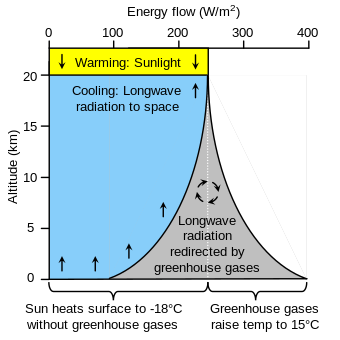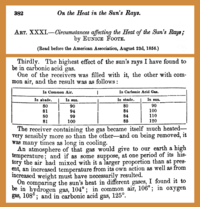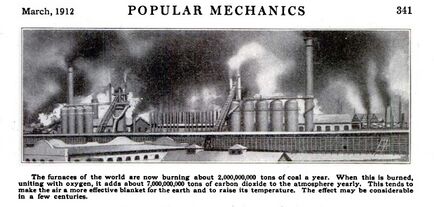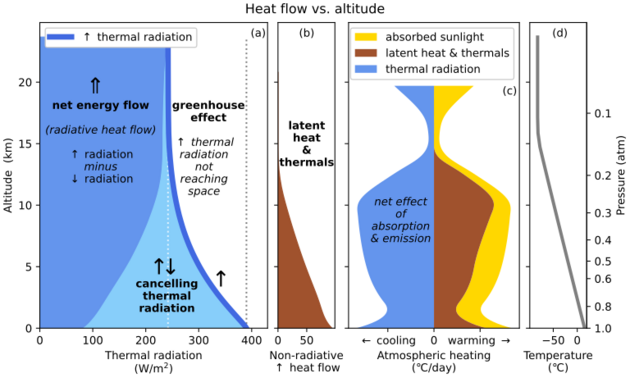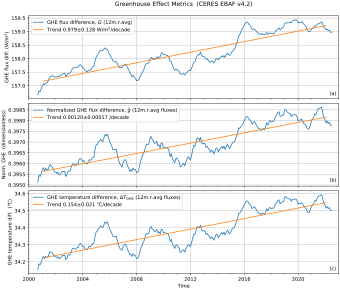Earth:Greenhouse effect
The greenhouse effect occurs when greenhouse gases in a planet's atmosphere trap some of the heat radiated from the planet's surface, raising its temperature. This process happens because stars emit shortwave radiation that passes through greenhouse gases, but planets emit longwave radiation that is partly absorbed by greenhouse gases. That difference reduces the rate at which a planet can cool off in response to being warmed by its host star. Adding to greenhouse gases further reduces the rate a planet emits radiation to space, raising its average surface temperature.
The Earth's average surface temperature would be about −18 °C (−0.4 °F) without the greenhouse effect,[1][2] compared to Earth's 20th century average of about 14 °C (57 °F), or a more recent average of about 15 °C (59 °F).[3][4] In addition to naturally present greenhouse gases, burning of fossil fuels has increased amounts of carbon dioxide and methane in the atmosphere.[5][6] As a result, global warming of about 1.2 °C (2.2 °F) has occurred since the Industrial Revolution,[7] with the global average surface temperature increasing at a rate of 0.18 °C (0.32 °F) per decade since 1981.[8]
The wavelengths of radiation emitted by the Sun and Earth differ because their surface temperatures are different. The Sun has a surface temperature of 5,500 °C (9,900 °F), so it emits most of its energy as shortwave radiation in near-infrared and visible wavelengths (as sunlight). In contrast, Earth's surface has a much lower temperature, so it emits longwave radiation at mid- and far-infrared wavelengths (sometimes called thermal radiation or radiated heat).[6] A gas is a greenhouse gas if it absorbs longwave radiation. Earth's atmosphere absorbs only 23% of incoming shortwave radiation, but absorbs 90% of the longwave radiation emitted by the surface,[9] thus accumulating energy and warming the Earth's surface.
The existence of the greenhouse effect, while not named as such, was proposed as early as 1824 by Joseph Fourier.[10] The argument and the evidence were further strengthened by Claude Pouillet in 1827 and 1838. In 1856 Eunice Newton Foote demonstrated that the warming effect of the sun is greater for air with water vapour than for dry air, and the effect is even greater with carbon dioxide.[11][12] The term greenhouse was first applied to this phenomenon by Nils Gustaf Ekholm in 1901.[13][14]
Definition
The greenhouse effect on Earth is defined as: "The infrared radiative effect of all infrared absorbing constituents in the atmosphere. Greenhouse gases (GHGs), clouds, and some aerosols absorb terrestrial radiation emitted by the Earth’s surface and elsewhere in the atmosphere."[15](p2232)
The enhanced greenhouse effect describes the fact that by increasing the concentration of GHGs in the atmosphere (due to human action), the natural greenhouse effect is increased.[15](p2232)
Terminology
The term greenhouse effect comes from an analogy to greenhouses. Both greenhouses and the greenhouse effect work by retaining heat from sunlight, but the way they retain heat differs. Greenhouses retain heat mainly by blocking convection (the movement of air).[16][17] In contrast, the greenhouse effect retains heat by restricting radiative transfer through the air and reducing the rate at which heat escapes to space.[5]
History of discovery and investigation
The existence of the greenhouse effect, while not named as such, was proposed as early as 1824 by Joseph Fourier.[19] The argument and the evidence were further strengthened by Claude Pouillet in 1827 and 1838. In 1856 Eunice Newton Foote demonstrated that the warming effect of the sun is greater for air with water vapour than for dry air, and the effect is even greater with carbon dioxide. She concluded that "An atmosphere of that gas would give to our earth a high temperature..."[20][21]
John Tyndall was the first to measure the infrared absorption and emission of various gases and vapors. From 1859 onwards, he showed that the effect was due to a very small proportion of the atmosphere, with the main gases having no effect, and was largely due to water vapor, though small percentages of hydrocarbons and carbon dioxide had a significant effect.[22] The effect was more fully quantified by Svante Arrhenius in 1896, who made the first quantitative prediction of global warming due to a hypothetical doubling of atmospheric carbon dioxide.[23] The term greenhouse was first applied to this phenomenon by Nils Gustaf Ekholm in 1901.[24][25]
Measurement
File:Climate Factor CO₂ (ZDF, Terra X).webm Matter emits thermal radiation in an amount that is directly proportional to the fourth power of its temperature. Some of the radiation emitted by the Earth's surface is absorbed by greenhouse gases and clouds. Without this absorption, Earth's surface would have an average temperature of −18 °C (−0.4 °F). However, because some of the radiation is absorbed, Earth's average surface temperature is around 15 °C (59 °F). Thus, the Earth's greenhouse effect may be measured as a temperature change of 33 °C (59 °F).
Thermal radiation is characterized by how much energy it carries, typically in watts per square meter (W/m2). Scientists also measure the greenhouse effect based on how much more longwave thermal radiation leaves the Earth's surface than reaches space.[26]:968[26]:934[27][28][29] Currently, longwave radiation leaves the surface at an average rate of 398 W/m2, but only 239 W/m2 reaches space. Thus, the Earth's greenhouse effect can also be measured as an energy flow change of 159 W/m2.[26]:968[26]:934 The greenhouse effect can be expressed as a fraction (0.40) or percentage (40%) of the longwave thermal radiation that leaves Earth's surface but does not reach space.[26]:968[27][30]
Whether the greenhouse effect is expressed as a change in temperature or as a change in longwave thermal radiation, the same effect is being measured.[27]
Role in climate change

Strengthening of the greenhouse effect through additional greenhouse gases from human activities is known as the enhanced greenhouse effect.[15](p2232) As well as being inferred from measurements by ARGO, CERES and other instruments throughout the 21st century,[32](p7–17) this increase in radiative forcing from human activity has been observed directly,[33][34] and is attributable mainly to increased atmospheric carbon dioxide levels.[35]
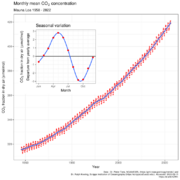
CO
2 is produced by fossil fuel burning and other activities such as cement production and tropical deforestation.[36] Measurements of CO
2 from the Mauna Loa Observatory show that concentrations have increased from about 313 parts per million (ppm)[37] in 1960, passing the 400 ppm milestone in 2013.[38] The current observed amount of CO
2 exceeds the geological record maxima (≈300 ppm) from ice core data.[39]
Over the past 800,000 years,[40] ice core data shows that carbon dioxide has varied from values as low as 180 ppm to the pre-industrial level of 270 ppm.[41] Paleoclimatologists consider variations in carbon dioxide concentration to be a fundamental factor influencing climate variations over this time scale.[42][43]
Energy balance and temperature
Incoming shortwave radiation
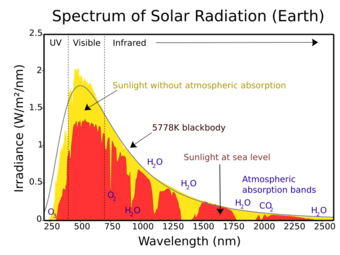
Hotter matter emits shorter wavelengths of radiation. As a result, the Sun emits shortwave radiation as sunlight while the Earth and its atmosphere emit longwave radiation. Sunlight includes ultraviolet, visible light, and near-infrared radiation.[15]:2251
Sunlight is reflected and absorbed by the Earth and its atmosphere. The atmosphere and clouds reflect about 23% and absorb 23%. The surface reflects 7% and absorbs 48%.[9] Overall, Earth reflects about 30% of the incoming sunlight,[44][45] and absorbs the rest (240 W/m2).[26]:934
Outgoing longwave radiation
The Earth and its atmosphere emit longwave radiation, also known as thermal infrared or terrestrial radiation.[15]:2251 Informally, longwave radiation is sometimes called thermal radiation. Outgoing longwave radiation (OLR) is the radiation from Earth and its atmosphere that passes through the atmosphere and into space.
The greenhouse effect can be directly seen in graphs of Earth's outgoing longwave radiation as a function of frequency (or wavelength). The area between the curve for longwave radiation emitted by Earth's surface and the curve for outgoing longwave radiation indicates the size of the greenhouse effect.[29]
Different substances are responsible for reducing the radiation energy reaching space at different frequencies; for some frequencies, multiple substances play a role.[28] Carbon dioxide is understood to be responsible for the dip in outgoing radiation (and associated rise in the greenhouse effect) at around 667 cm−1 (equivalent to a wavelength of 15 microns).[46]
Each layer of the atmosphere with greenhouse gases absorbs some of the longwave radiation being radiated upwards from lower layers. It also emits longwave radiation in all directions, both upwards and downwards, in equilibrium with the amount it has absorbed. This results in less radiative heat loss and more warmth below. Increasing the concentration of the gases increases the amount of absorption and emission, and thereby causing more heat to be retained at the surface and in the layers below.[47]
Effective temperature
The power of outgoing longwave radiation emitted by a planet corresponds to the effective temperature of the planet. The effective temperature is the temperature that a planet radiating with a uniform temperature (a blackbody) would need to have in order to radiate the same amount of energy.
This concept may be used to compare the amount of longwave radiation emitted to space and the amount of longwave radiation emitted by the surface:
- Emissions to space: Based on its emissions of longwave radiation to space, Earth's overall effective temperature is −18 °C (0 °F).[48][47]
- Emissions from surface: Based on thermal emissions from the surface, Earth's effective surface temperature is about 16 °C (61 °F),[26]:934 which is 34 °C (61 °F) warmer than Earth's overall effective temperature.
Earth's surface temperature is often reported in terms of the average near-surface air temperature. This is about 15 °C (59 °F),[4][49] a bit lower than the effective surface temperature. This value is 33 °C (59 °F) warmer than Earth's overall effective temperature.
Energy flux
Energy flux is the rate of energy flow per unit area. Energy flux is expressed in units of W/m2, which is the number of joules of energy that pass through a square meter each second. Most fluxes quoted in high-level discussions of climate are global values, which means they are the total flow of energy over the entire globe, divided by the surface area of the Earth, 5.1×1014 m2 (5.1×108 km2; 2.0×108 sq mi).[50]
The fluxes of radiation arriving at and leaving the Earth are important because radiative transfer is the only process capable of exchanging energy between Earth and the rest of the universe.[51]:145
Radiative balance
The temperature of a planet depends on the balance between incoming radiation and outgoing radiation. If incoming radiation exceeds outgoing radiation, a planet will warm. If outgoing radiation exceeds incoming radiation, a planet will cool. A planet will tend towards a state of radiative equilibrium, in which the power of outgoing radiation equals the power of absorbed incoming radiation.[52]
Earth's energy imbalance is the amount by which the power of incoming sunlight absorbed by Earth's surface or atmosphere exceeds the power of outgoing longwave radiation emitted to space. Energy imbalance is the fundamental measurement that drives surface temperature.[53] A United Nations presentation says "The EEI is the most critical number defining the prospects for continued global warming and climate change."[54] One study argues, "The absolute value of EEI represents the most fundamental metric defining the status of global climate change."[55]
Earth's energy imbalance (EEI) was about 0.7 W/m2 as of around 2015, indicating that Earth as a whole is accumulating thermal energy and is in a process of becoming warmer.[26]:934
Over 90% of the retained energy goes into warming the oceans, with much smaller amounts going into heating the land, atmosphere, and ice.[56]
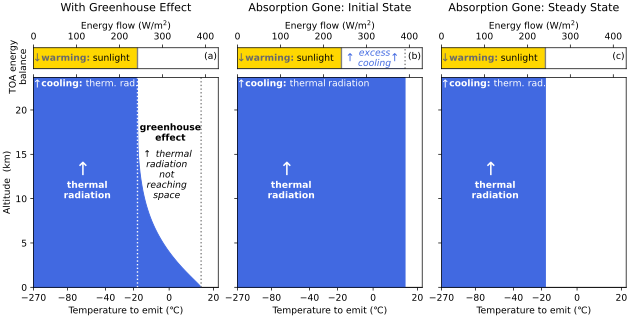
Day and night cycle
A simple picture assumes a steady state, but in the real world, the day/night (diurnal) cycle, as well as the seasonal cycle and weather disturbances, complicate matters. Solar heating applies only during daytime. At night the atmosphere cools somewhat, but not greatly because the thermal inertia of the climate system resists changes both day and night, as well as for longer periods.[58] Diurnal temperature changes decrease with height in the atmosphere.
Effect of lapse rate
Lapse rate
In the lower portion of the atmosphere, the troposphere, the air temperature decreases (or "lapses") with increasing altitude. The rate at which temperature changes with altitude is called the lapse rate.[59]
On Earth, the air temperature decreases by about 6.5°C/km (3.6°F per 1000 ft), on average, although this varies.[59]
The temperature lapse is caused by convection. Air warmed by the surface rises. As it rises, air expands and cools. Simultaneously, other air descends, compresses, and warms. This process creates a vertical temperature gradient within the atmosphere.[59]
This vertical temperature gradient is essential to the greenhouse effect. If the lapse rate was zero (so that the atmospheric temperature did not vary with altitude and was the same as the surface temperature) then there would be no greenhouse effect (i.e., its value would be zero).[60]
Emission temperature and altitude

Greenhouse gases make the atmosphere near Earth's surface mostly opaque to longwave radiation. The atmosphere only becomes transparent to longwave radiation at higher altitudes, where the air is less dense, there is less water vapor, and reduced pressure broadening of absorption lines limits the wavelengths that gas molecules can absorb.[61][51]
For any given wavelength, the longwave radiation that reaches space is emitted by a particular radiating layer of the atmosphere. The intensity of the emitted radiation is determined by the weighted average air temperature within that layer. So, for any given wavelength of radiation emitted to space, there is an associated effective emission temperature (or brightness temperature).[62][51]
A given wavelength of radiation may also be said to have an effective emission altitude, which is a weighted average of the altitudes within the radiating layer.
The effective emission temperature and altitude vary by wavelength (or frequency). This phenomenon may be seen by examining plots of radiation emitted to space.[62]
Greenhouse gases and the lapse rate
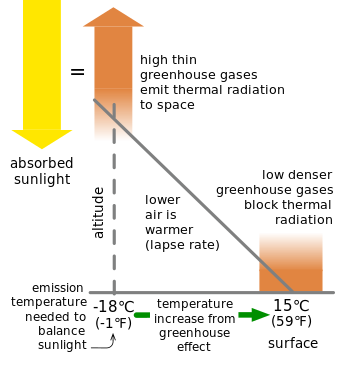
Earth's surface radiates longwave radiation with wavelengths in the range of 4–100 microns.[63] Greenhouse gases that were largely transparent to incoming solar radiation are more absorbent for some wavelengths in this range.[63]
The atmosphere near the Earth's surface is largely opaque to longwave radiation and most heat loss from the surface is by evaporation and convection. However radiative energy losses become increasingly important higher in the atmosphere, largely because of the decreasing concentration of water vapor, an important greenhouse gas.
Rather than thinking of longwave radiation headed to space as coming from the surface itself, it is more realistic to think of this outgoing radiation as being emitted by a layer in the mid-troposphere, which is effectively coupled to the surface by a lapse rate. The difference in temperature between these two locations explains the difference between surface emissions and emissions to space, i.e., it explains the greenhouse effect.[64][65]
Infrared absorbing constituents in the atmosphere
Greenhouse gases
- A greenhouse gas (GHG) is a gas which contributes to the trapping of heat by impeding the flow of longwave radiation out of a planet's atmosphere. Greenhouse gases contribute most of the greenhouse effect in Earth's energy budget.[15]
Infrared active gases
Gases which can absorb and emit longwave radiation are said to be infrared active[66] and act as greenhouse gases.
Most gases whose molecules have two different atoms (such as carbon monoxide, CO), and all gases with three or more atoms (including H
2O and CO
2), are infrared active and act as greenhouse gases. (Technically, this is because when these molecules vibrate, those vibrations modify the molecular dipole moment, or asymmetry in the distribution of electrical charge. See Infrared spectroscopy.)[15]
Gases with only one atom (such as argon, Ar) or with two identical atoms (such as nitrogen, N2, and oxygen, O2) are not infrared active. They are transparent to longwave radiation, and, for practical purposes, do not absorb or emit longwave radiation. (This is because their molecules are symmetrical and so do not have a dipole moment.) Such gases make up more than 99% of the dry atmosphere.[15]
Absorption and emission
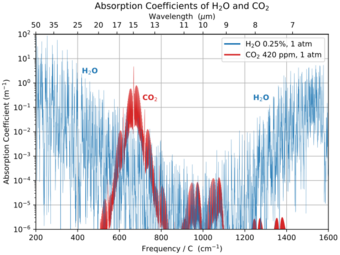
Greenhouse gases absorb and emit longwave radiation within specific ranges of wavelengths (organized as spectral lines or bands).[15]
When greenhouse gases absorb radiation, they distribute the acquired energy to the surrounding air as thermal energy (i.e., kinetic energy of gas molecules). Energy is transferred from greenhouse gas molecules to other molecules via molecular collisions.[67]
Contrary to what is sometimes said, greenhouse gases do not "re-emit" photons after they are absorbed. Because each molecule experiences billions of collisions per second, any energy a greenhouse gas molecule receives by absorbing a photon will be redistributed to other molecules before there is a chance for a new photon to be emitted.[67]
In a separate process, greenhouse gases emit longwave radiation, at a rate determined by the air temperature. This thermal energy is either absorbed by other greenhouse gas molecules or leaves the atmosphere, cooling it.[67]
Radiative effects
Effect on air: Air is warmed by latent heat (buoyant water vapor condensing into water droplets and releasing heat), thermals (warm air rising from below), and by sunlight being absorbed in the atmosphere.[6] Air is cooled radiatively, by greenhouse gases and clouds emitting longwave thermal radiation. Within the troposphere, greenhouse gases typically have a net cooling effect on air, emitting more thermal radiation than they absorb. Warming and cooling of air are well balanced, on average, so that the atmosphere maintains a roughly stable average temperature.[51]:139[68]
Effect on surface cooling: Longwave radiation flows both upward and downward due to absorption and emission in the atmosphere. These canceling energy flows reduce radiative surface cooling (net upward radiative energy flow). Latent heat transport and thermals provide non-radiative surface cooling which partially compensates for this reduction, but there is still a net reduction in surface cooling, for a given surface temperature.[51]:139[68]
Effect on TOA energy balance: Greenhouse gases impact the top-of-atmosphere (TOA) energy budget by reducing the flux of longwave radiation emitted to space, for a given surface temperature. Thus, greenhouse gases alter the energy balance at TOA. This means that the surface temperature needs to be higher (than the planet's effective temperature, i.e., the temperature associated with emissions to space), in order for the outgoing energy emitted to space to balance the incoming energy from sunlight.[51]:139[68] It is important to focus on the top-of-atmosphere (TOA) energy budget (rather than the surface energy budget) when reasoning about the warming effect of greenhouse gases.[69]:414
Clouds and aerosols
Clouds and aerosols have both cooling effects, associated with reflecting sunlight back to space, and warming effects, associated with trapping thermal radiation.
On average, clouds have a strong net cooling effect. However, the mix of cooling and warming effects varies, depending on detailed characteristics of particular clouds (including their type, height, and optical properties).[70] Thin cirrus clouds can have a net warming effect. Clouds can absorb and emit infrared radiation and thus affect the radiative properties of the atmosphere.[71]
Basic formulas
Effective temperature
A given flux of thermal radiation has an associated effective radiating temperature or effective temperature. Effective temperature is the temperature that a black body (a perfect absorber/emitter) would need to be to emit that much thermal radiation.[72] Thus, the overall effective temperature of a planet is given by
- [math]\displaystyle{ T_\mathrm{eff} = (\mathrm{OLR}/\sigma)^{1/4} }[/math]
where OLR is the average flux (power per unit area) of outgoing longwave radiation emitted to space and [math]\displaystyle{ \sigma }[/math] is the Stefan-Boltzmann constant. Similarly, the effective temperature of the surface is given by
- [math]\displaystyle{ T_\mathrm{surface,eff} = (\mathrm{SLR}/\sigma)^{1/4} }[/math]
where SLR is the average flux of longwave radiation emitted by the surface. (OLR is a conventional abbreviation. SLR is used here to denote the flux of surface-emitted longwave radiation, although there is no standard abbreviation for this.)[73]
Metrics for the greenhouse effect
The IPCC reports the greenhouse effect, G, as being 159 W m-2, where G is the flux of longwave thermal radiation that leaves the surface minus the flux of outgoing longwave radiation that reaches space:[26]:968[27][29][28]
- [math]\displaystyle{ G = \mathrm{SLR} - \mathrm{OLR}\;. }[/math]
Alternatively, the greenhouse effect can be described using the normalized greenhouse effect, g̃, defined as
- [math]\displaystyle{ \tilde g = G/\mathrm{SLR} = 1 - \mathrm{OLR}/\mathrm{SLR}\;. }[/math]
The normalized greenhouse effect is the fraction of the amount of thermal radiation emitted by the surface that does not reach space. Based on the IPCC numbers, g̃ = 0.40. In other words, 40 percent less thermal radiation reaches space than what leaves the surface.[26]:968[27][30]
Sometimes the greenhouse effect is quantified as a temperature difference. This temperature difference is closely related to the quantities above.
When the greenhouse effect is expressed as a temperature difference, [math]\displaystyle{ \Delta T_\mathrm{GHE} }[/math], this refers to the effective temperature associated with thermal radiation emissions from the surface minus the effective temperature associated with emissions to space:
- [math]\displaystyle{ \Delta T_\mathrm{GHE} = T_\mathrm{surface,eff} - T_\mathrm{eff} }[/math]
- [math]\displaystyle{ \Delta T_\mathrm{GHE} = \left(\mathrm{SLR}/\sigma\right)^{1/4} - \left(\mathrm{OLR}/\sigma\right)^{1/4} }[/math]
Informal discussions of the greenhouse effect often compare the actual surface temperature to the temperature that the planet would have if there were no greenhouse gases. However, in formal technical discussions, when the size of the greenhouse effect is quantified as a temperature, this is generally done using the above formula. The formula refers to the effective surface temperature rather than the actual surface temperature, and compares the surface with the top of the atmosphere, rather than comparing reality to a hypothetical situation.[73]
The temperature difference, [math]\displaystyle{ \Delta T_\mathrm{GHE} }[/math], indicates how much warmer a planet's surface is than the planet's overall effective temperature.
Radiative balance
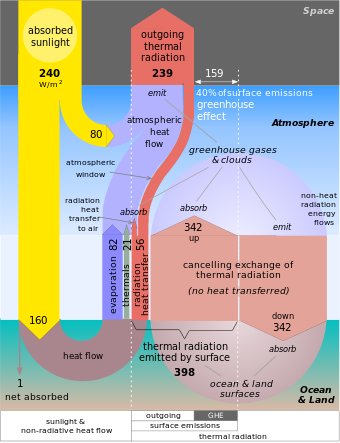
Earth's top-of-atmosphere (TOA) energy imbalance (EEI) is the amount by which the power of incoming radiation exceeds the power of outgoing radiation:[54]
- [math]\displaystyle{ \mathrm{EEI} = \mathrm{ASR} -\mathrm{OLR} }[/math]
where ASR is the mean flux of absorbed solar radiation. ASR may be expanded as
- [math]\displaystyle{ \mathrm{ASR} = (1-A) \,\mathrm{MSI} }[/math]
where [math]\displaystyle{ A }[/math] is the albedo (reflectivity) of the planet and MSI is the mean solar irradiance incoming at the top of the atmosphere.
The radiative equilibrium temperature of a planet can be expressed as
- [math]\displaystyle{ T_\mathrm{radeq} = (\mathrm{ASR}/\sigma)^{1/4} = \left[(1-A)\,\mathrm{MSI}/\sigma \right]^{1/4} \;. }[/math]
A planet's temperature will tend to shift towards a state of radiative equilibrium, in which the TOA energy imbalance is zero, i.e., [math]\displaystyle{ \mathrm{EEI} = 0 }[/math]. When the planet is in radiative equilibrium, the overall effective temperature of the planet is given by
- [math]\displaystyle{ T_\mathrm{eff} = T_\mathrm{radeq}\;. }[/math]
Thus, the concept of radiative equilibrium is important because it indicates what effective temperature a planet will tend towards having.[74][57]
If, in addition to knowing the effective temperature, [math]\displaystyle{ T_\mathrm{eff} }[/math], we know the value of the greenhouse effect, then we know the mean (average) surface temperature of the planet.
This is why the quantity known as the greenhouse effect is important: it is one of the few quantities that go into determining the planet's mean surface temperature.
Greenhouse effect and temperature
Typically, a planet will be close to radiative equilibrium, with the rates of incoming and outgoing energy being well-balanced. Under such conditions, the planet's equilibrium temperature is determined by the mean solar irradiance and the planetary albedo (how much sunlight is reflected back to space instead of being absorbed).
The greenhouse effect measures how much warmer the surface is than the overall effective temperature of the planet. So, the effective surface temperature, [math]\displaystyle{ T_\mathrm{surface,eff} }[/math], is, using the definition of [math]\displaystyle{ \Delta T_\mathrm{GHE} }[/math],
- [math]\displaystyle{ T_\mathrm{surface,eff} = T_\mathrm{eff} + \Delta T_\mathrm{GHE} \;. }[/math]
One could also express the relationship between [math]\displaystyle{ T_\mathrm{surface,eff} }[/math] and [math]\displaystyle{ T_\mathrm{eff} }[/math] using G or g̃.
So, the principle that a larger greenhouse effect corresponds to a higher surface temperature, if everything else (i.e., the factors that determine [math]\displaystyle{ T_\mathrm{eff} }[/math]) is held fixed, is true as a matter of definition.
Note that the greenhouse effect influences the temperature of the planet as a whole, in tandem with the planet's tendency to move toward radiative equilibrium.[75]
Misconceptions
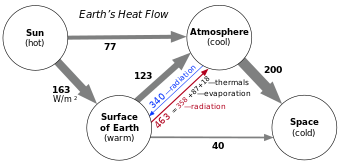
There are sometimes misunderstandings about how the greenhouse effect functions and raises temperatures.
The surface budget fallacy is a common error in thinking.[69]:413 It involves thinking that an increased CO
2 concentration could only cause warming by increasing the downward thermal radiation to the surface, as a result of making the atmosphere a better emitter. If the atmosphere near the surface is already nearly opaque to thermal radiation, this would mean that increasing CO
2 could not lead to higher temperatures. However, it is a mistake to focus on the surface energy budget rather than the top-of-atmosphere energy budget. Regardless of what happens at the surface, increasing the concentration of CO
2 tends to reduce the thermal radiation reaching space (OLR), leading to a TOA energy imbalance that leads to warming. Earlier researchers like Callendar (1938) and Plass (1959) focused on the surface budget, but the work of Manabe in the 1960s clarified the importance of the top-of-atmosphere energy budget.[69]:414
Among those who do not believe in the greenhouse effect, there is a fallacy that the greenhouse effect involves greenhouse gases sending heat from the cool atmosphere to the planet's warm surface, in violation of the Second Law of Thermodynamics.[76][77] However, this idea reflects a misunderstanding. Radiation heat flow is the net energy flow after the flows of radiation in both directions have been taken into account.[75] Radiation heat flow occurs in the direction from the surface to the atmosphere and space,[6] as is to be expected given that the surface is warmer than the atmosphere and space. While greenhouse gases emit thermal radiation downward to the surface, this is part of the normal process of radiation heat transfer.[78] The downward thermal radiation simply reduces the upward thermal radiation net energy flow (radiation heat flow), i.e., it reduces cooling.[67]
Simplified models

Simplified models are sometimes used to support understanding of how the greenhouse effect comes about and how this affects surface temperature.
Atmospheric layer models
The greenhouse effect can be seen to occur in a simplified model in which the air is treated as if it is single uniform layer exchanging radiation with the ground and space.[79] Slightly more complex models add additional layers, or introduce convection.[80]
Equivalent emission altitude
One simplification is to treat all outgoing longwave radiation as being emitted from an altitude where the air temperature equals the overall effective temperature for planetary emissions, [math]\displaystyle{ T_\mathrm{eff} }[/math].[81] Some authors have referred to this altitude as the effective radiating level (ERL), and suggest that as the CO
2 concentration increases, the ERL must rise to maintain the same mass of CO
2 above that level.[82]
This approach is less accurate than accounting for variation in radiation wavelength by emission altitude. However, it can be useful in supporting a simplified understanding of the greenhouse effect.[81] For instance, it can be used to explain how the greenhouse effect increases as the concentration of greenhouse gases increase.[83][82][65]
Earth's overall equivalent emission altitude has been increasing with a trend of 23 m (75 ft)/decade, which is said to be consistent with a global mean surface warming of 0.12 °C (0.22 °F)/decade over the period 1979–2011.[81]
Related effects on Earth
Negative greenhouse effect
Scientists have observed that, at times, there is a negative greenhouse effect over parts of Antarctica.[84][85] In a location where there is a strong temperature inversion, so that the air is warmer than the surface, it is possible for the greenhouse effect to be reversed, so that the presence of greenhouse gases increases the rate of radiative cooling to space. In this case, the rate of thermal radiation emission to space is greater than the rate at which thermal radiation is emitted by the surface. Thus, the local value of the greenhouse effect is negative.
Runaway greenhouse effect
Bodies other than Earth
| Venus | Earth | Mars | Titan | |
|---|---|---|---|---|
| Surface temperature, [math]\displaystyle{ T_\mathrm{observed} }[/math] | 735 K (462 °C; 863 °F) | 288 K (15 °C; 59 °F) | 215 K (−58 °C; −73 °F) | 94 K (−179 °C; −290 °F) |
| Greenhouse effect, [math]\displaystyle{ \Delta T}_\mathrm{GHE }[/math] | 503 K (905 °F) | 33 K (59 °F) | 6 K (11 °F) | 21 K (38 °F) GHE; 12 K (22 °F) GHE+AGHE |
| Pressure | 92 atm | 1 atm | 0.0063 atm | 1.5 atm |
| Primary gases | CO 2 (0.965) N2 (0.035) |
N2 (0.78) O2 (0.21) Ar (0.009) |
CO 2 (0.95) N2 (0.03) Ar (0.02) |
N2 (0.95) CH 4 (~0.05) |
| Trace gases | SO 2, Ar |
H 2O, CO 2 |
O2, CO | H2 |
| Planetary effective temperature, [math]\displaystyle{ T_\mathrm{eff} }[/math] | 232 K (−41 °C; −42 °F) | 255 K (−18 °C; −1 °F) | 209 K (−64 °C; −83 °F) | 73 K tropopause; 82 K stratopause |
| Greenhouse effect, [math]\displaystyle{ G }[/math] | 16000 W/m2 | 150 W/m2 | 13 W/m2 | 2.8 W/m2 GHE; 1.9 W/m2 GHE+AGHE |
| Normalized greenhouse effect, [math]\displaystyle{ \tilde g }[/math] | 0.99 | 0.39 | 0.11 | 0.63 GHE; 0.42 GHE+AGHE |
In the solar system, apart from the Earth, at least two other planets and a moon also have a greenhouse effect.
Venus
The greenhouse effect on Venus is particularly large, and it brings the surface temperature to as high as 735 K (462 °C; 863 °F). This is due to its very dense atmosphere which consists of about 97% carbon dioxide.[87]
Although Venus is about 30% closer to the Sun, it absorbs (and is warmed by) less sunlight than Earth, because Venus reflects 77% of incident sunlight while Earth reflects around 30%. In the absence of a greenhouse effect, the surface of Venus would be expected to have a temperature of 232 K (−41 °C; −42 °F). Thus, contrary to what one might think, being nearer to the Sun is not a reason why Venus is warmer than Earth.[89][90][91]
Due to its high pressure, the CO2 in the atmosphere of Venus exhibits continuum absorption (absorption over a broad range of wavelengths) and is not limited to absorption within the bands relevant to its absorption on Earth.[62]
A runaway greenhouse effect involving carbon dioxide and water vapor has for many years been hypothesized to have occurred on Venus;[92] this idea is still largely accepted.[93] The planet Venus experienced a runaway greenhouse effect, resulting in an atmosphere which is 96% carbon dioxide, and a surface atmospheric pressure roughly the same as found 900 m (3,000 ft) underwater on Earth. Venus may have had water oceans, but they would have boiled off as the mean surface temperature rose to the current 735 K (462 °C; 863 °F).[94][95][96]
Mars
Mars has about 70 times as much carbon dioxide as Earth,[97] but experiences only a small greenhouse effect, about 6 K (11 °F).[86] The greenhouse effect is small due to the lack of water vapor and the overall thinness of the atmosphere.[98]
The same radiative transfer calculations that predict warming on Earth accurately explain the temperature on Mars, given its atmospheric composition.[99][100][73]
Titan
Saturn's moon Titan has both a greenhouse effect and an anti-greenhouse effect. The presence of nitrogen (N2), methane (CH4), and hydrogen (H2) in the atmosphere contribute to a greenhouse effect, increasing the surface temperature by 21 K (38 °F) over the expected temperature of the body without these gases.[87][101]
While the gases N2 and H2 ordinarily do not absorb infrared radiation, these gases absorb thermal radiation on Titan due to pressure-induced collisions, the large mass and thickness of the atmosphere, and the long wavelengths of the thermal radiation from the cold surface.[62][87][101]
The existence of a high-altitude haze, which absorbs wavelengths of solar radiation but is transparent to infrared, contribute to an anti-greenhouse effect of approximately 9 K (16 °F).[87][101]
The net result of these two effects is a warming of 21 K − 9 K = 12 K (22 °F), so Titan's surface temperature of 94 K (−179 °C; −290 °F) is 12 K warmer than it would be if there were no atmosphere.[87][101]
Effect of pressure
One cannot predict the relative sizes of the greenhouse effects on different bodies simply by comparing the amount of greenhouse gases in their atmospheres. This is because factors other than the quantity of these gases also play a role in determining the size of the greenhouse effect.
Overall atmospheric pressure affects how much thermal radiation each molecule of a greenhouse gas can absorb. High pressure leads to more absorption and low pressure leads to less.[62]
This is due to "pressure broadening" of spectral lines. When the total atmospheric pressure is higher, collisions between molecules occur at a higher rate. Collisions broaden the width of absorption lines, allowing a greenhouse gas to absorb thermal radiation over a broader range of wavelengths.[69]:226
Each molecule in the air near Earth's surface experiences about 7 billion collisions per second. This rate is lower at higher altitudes, where the pressure and temperature are both lower.[102] This means that greenhouse gases are able to absorb more wavelengths in the lower atmosphere than they can in the upper atmosphere.[61][51]
On other planets, pressure broadening means that each molecule of a greenhouse gas is more effective at trapping thermal radiation if the total atmospheric pressure is high (as on Venus), and less effective at trapping thermal radiation if the atmospheric pressure is low (as on Mars).[62]
Anti-greenhouse effect
See also
- Climate change feedback
- Climate model
- Global dimming
- Idealized greenhouse model
- Illustrative model of greenhouse effect on climate change
- Solar radiation management
References
- ↑ "Solar Radiation and the Earth's Energy Balance". The Climate System – EESC 2100 Spring 2007. Columbia University. http://eesc.columbia.edu/courses/ees/climate/lectures/radiation/.
- ↑ "Historical Overview of Climate Change Science". Climate Change 2007: The Physical Science Basis. Contribution of Working Group I to the Fourth Assessment Report of the Intergovernmental Panel on Climate Change. Cambridge, UK and New York, NY: Cambridge University Press. 2007. p. 97. http://www.ipcc.ch/pdf/assessment-report/ar4/wg1/ar4-wg1-chapter1.pdf. Retrieved 25 March 2014.
- ↑ "The Elusive Absolute Surface Air Temperature (SAT)". NOAA. http://data.giss.nasa.gov/gistemp/abs_temp.html.
- ↑ 4.0 4.1 "Yearly average temperature". https://climatechangetracker.org/global-warming/yearly-average-temperature.
- ↑ 5.0 5.1 A concise description of the greenhouse effect is given in the Intergovernmental Panel on Climate Change Fourth Assessment Report, "What is the Greenhouse Effect?" FAQ 1.3 – AR4 WGI Chapter 1: Historical Overview of Climate Change Science , IIPCC Fourth Assessment Report, Chapter 1, page 115: "To balance the absorbed incoming [solar] energy, the Earth must, on average, radiate the same amount of energy back to space. Because the Earth is much colder than the Sun, it radiates at much longer wavelengths, primarily in the infrared part of the spectrum (see Figure 1). Much of this thermal radiation emitted by the land and ocean is absorbed by the atmosphere, including clouds, and reradiated back to Earth. This is called the greenhouse effect."
Schneider, Stephen H. (2001). "Global Climate Change in the Human Perspective". in Bengtsson, Lennart O.; Hammer, Claus U.. Geosphere-biosphere Interactions and Climate. Cambridge University Press. pp. 90–91. ISBN 978-0-521-78238-8. https://books.google.com/books?id=MsASkmCPDpcC&pg=PA90. Retrieved 31 May 2018.
Claussen, E.; Cochran, V.A.; Davis, D.P., eds (2001). "Global Climate Data". Climate Change: Science, Strategies, & Solutions. University of Michigan. p. 373. ISBN 978-9004120242. https://books.google.com/books?id=g85OJ76ufJoC&pg=PA373. Retrieved 1 June 2018.
Allaby, A.; Allaby, M. (1999). A Dictionary of Earth Sciences. Oxford University Press. p. 244. ISBN 978-0-19-280079-4. https://archive.org/details/dictionaryofeart00alla/page/244. - ↑ 6.0 6.1 6.2 6.3 Rebecca, Lindsey (2009-01-14). "Climate and Earth's Energy Budget : Feature Articles". https://earthobservatory.nasa.gov/features/EnergyBalance/page1.php.
- ↑ Fox, Alex. "Atmospheric Carbon Dioxide Reaches New High Despite Pandemic Emissions Reduction" (in en). https://www.smithsonianmag.com/smart-news/atmospheric-carbon-dioxide-reaches-new-high-despite-pandemic-emissions-reduction-180977945/.
- ↑ Lindsey, Rebecca; Dahlman, Luann. "Climate Change: Global Temperature". https://www.climate.gov/news-features/understanding-climate/climate-change-global-temperature#:~:text=Earth's%20temperature%20has%20risen%20by,0.18%C2%B0%20C)%20per%20decade..
- ↑ 9.0 9.1 "What is Earth's Energy Budget? Five Questions with a Guy Who Knows". 10 April 2017. https://www.nasa.gov/feature/langley/what-is-earth-s-energy-budget-five-questions-with-a-guy-who-knows.
- ↑ Fourier, J. (1824). "Remarques Generales sur les Temperatures Du Globe Terrestre et des Espaces Planetaires" (in fr). Annales de Chimie et de Physique 27: 136–167. https://books.google.com/books?id=1Jg5AAAAcAAJ&pg=PA136. Retrieved 8 June 2020.
- ↑ Foote, Eunice (November 1856). Circumstances affecting the Heat of the Sun's Rays. 22. pp. 382–383. https://books.google.com/books?id=6xhFAQAAMAAJ&pg=PA382. Retrieved 31 January 2016.
- ↑ Huddleston, Amara (17 July 2019). "Happy 200th birthday to Eunice Foote, hidden climate science pioneer". https://www.climate.gov/news-features/features/happy-200th-birthday-eunice-foote-hidden-climate-science-pioneer.
- ↑ Easterbrook, Steve (18 August 2015). "Who first coined the term "Greenhouse Effect"?". http://www.easterbrook.ca/steve/2015/08/who-first-coined-the-term-greenhouse-effect/.
- ↑ Ekholm N (1901). "On The Variations Of The Climate Of The Geological And Historical Past And Their Causes". Quarterly Journal of the Royal Meteorological Society 27 (117): 1–62. doi:10.1002/qj.49702711702. Bibcode: 1901QJRMS..27....1E.
- ↑ 15.0 15.1 15.2 15.3 15.4 15.5 15.6 15.7 15.8 IPCC, 2021: Annex VII: Glossary [Matthews, J.B.R., V. Möller, R. van Diemen, J.S. Fuglestvedt, V. Masson-Delmotte, C. Méndez, S. Semenov, A. Reisinger (eds.)]. In Climate Change 2021: The Physical Science Basis. Contribution of Working Group I to the Sixth Assessment Report of the Intergovernmental Panel on Climate Change [Masson-Delmotte, V., P. Zhai, A. Pirani, S.L. Connors, C. Péan, S. Berger, N. Caud, Y. Chen, L. Goldfarb, M.I. Gomis, M. Huang, K. Leitzell, E. Lonnoy, J.B.R. Matthews, T.K. Maycock, T. Waterfield, O. Yelekçi, R. Yu, and B. Zhou (eds.)]. Cambridge University Press, Cambridge, United Kingdom and New York, NY, USA, pp. 2215–2256, doi:10.1017/9781009157896.022.
- ↑ Worley, John. "Greenhouses: Heating, Cooling and Ventilation". https://extension.uga.edu/publications/detail.html?number=B792&title=greenhouses-heating-cooling-and-ventilation.
- ↑ Contribution of Working Group I to the Fourth Assessment Report of the Intergovernmental Panel on Climate Change, 2007, Chapter 1. Cambridge University Press, Cambridge, United Kingdom and New York, NY, USA.. p. 115. https://www.ipcc.ch/report/ar4/wg1/. Retrieved 24 March 2023. "The glass walls in a greenhouse reduce airflow and increase the temperature of the air inside. Analogously, but through a different physical process, the Earth's greenhouse effect warms the surface of the planet."
- ↑ Foote, Eunice, 1856. Circumstances affecting the heat of the Sun's rays": Art. XXXI, The American Journal of Science and Arts, 2nd Series, v. XXII/no. LXVI, November 1856, p. 382-383.
- ↑ Fourier, J. (1824). "Remarques Generales sur les Temperatures Du Globe Terrestre et des Espaces Planetaires" (in fr). Annales de Chimie et de Physique 27: 136–167. https://books.google.com/books?id=1Jg5AAAAcAAJ&pg=PA136. Retrieved 8 June 2020.
- ↑ Foote, Eunice (November 1856). Circumstances affecting the Heat of the Sun's Rays. 22. pp. 382–383. https://books.google.com/books?id=6xhFAQAAMAAJ&pg=PA382. Retrieved 31 January 2016.
- ↑ Huddleston, Amara (17 July 2019). "Happy 200th birthday to Eunice Foote, hidden climate science pioneer". https://www.climate.gov/news-features/features/happy-200th-birthday-eunice-foote-hidden-climate-science-pioneer.
- ↑ John Tyndall, Heat considered as a Mode of Motion (500 pages; year 1863, 1873)
- ↑ Held, Isaac M.; Soden, Brian J. (November 2000). "Water Vapor Feedback and Global Warming". Annual Review of Energy and the Environment 25: 441–475. doi:10.1146/annurev.energy.25.1.441.
- ↑ Easterbrook, Steve (18 August 2015). "Who first coined the term "Greenhouse Effect"?". http://www.easterbrook.ca/steve/2015/08/who-first-coined-the-term-greenhouse-effect/.
- ↑ Ekholm N (1901). "On The Variations Of The Climate Of The Geological And Historical Past And Their Causes". Quarterly Journal of the Royal Meteorological Society 27 (117): 1–62. doi:10.1002/qj.49702711702. Bibcode: 1901QJRMS..27....1E.
- ↑ 26.0 26.1 26.2 26.3 26.4 26.5 26.6 26.7 26.8 26.9 "Chapter 7: The Earth's Energy Budget, Climate Feedbacks, and Climate Sensitivity". Climate Change 2021: The Physical Science Basis. IPCC. 2021. https://www.ipcc.ch/report/ar6/wg1/downloads/report/IPCC_AR6_WGI_Chapter07.pdf. Retrieved 24 April 2023.
- ↑ 27.0 27.1 27.2 27.3 27.4 Raval, A.; Ramanathan, V. (1989). "Observational determination of the greenhouse effect". Nature 342 (6251): 758–761. doi:10.1038/342758a0. Bibcode: 1989Natur.342..758R. https://www.nature.com/articles/342758a0.
- ↑ 28.0 28.1 28.2 Schmidt, G. A.; Ruedy, R. A.; Miller, R. L.; Lacis, A. A. (2010). "Attribution of the present-day total greenhouse effect". Journal of Geophysical Research 115 (D20). doi:10.1029/2010JD014287. Bibcode: 2010JGRD..11520106S. https://pubs.giss.nasa.gov/docs/2010/2010_Schmidt_sc05400j.pdf. Retrieved 14 June 2023.
- ↑ 29.0 29.1 29.2 Gavin Schmidt (2010-10-01). "Taking the Measure of the Greenhouse Effect". NASA Goddard Institute for Space Studies - Science Briefs. https://www.giss.nasa.gov/research/briefs/2010_schmidt_05/.
- ↑ 30.0 30.1 Raval, A.; Ramanathan, V. (1990). "Observational determination of the greenhouse effect". Global Climate Feedbacks: Proceedings of the Brookhaven National Laboratory Workshop: 5–16. https://www.osti.gov/servlets/purl/6440147-fP92Pd/#page=10. Retrieved 24 April 2023.
- ↑ Joseph Atkinson (22 June 2021). "Earth Matters: Earth's Radiation Budget is Out of Balance". NASA Earth Observatory. https://earthobservatory.nasa.gov/blogs/earthmatters/2021/06/22/earths-radiation-budget-is-out-of-balance/.
- ↑ "IPCC AR6 WG1". https://www.ipcc.ch/report/ar6/wg1/downloads/report/IPCC_AR6_WGI_Full_Report.pdf.
- ↑ Robert McSweeney (2015-02-25). "New study directly measures greenhouse effect at Earth's surface". Carbon Brief. https://www.carbonbrief.org/new-study-directly-measures-greenhouse-effect-at-earths-surface.
- ↑ "Direct observations confirm that humans are throwing Earth's energy budget off balance". Science X. 2021-03-26. https://phys.org/news/2021-03-humans-earth-energy.html.
- ↑ "Enhanced Greenhouse Effect". Ace.mmu.ac.uk. http://www.ace.mmu.ac.uk/eae/Global_Warming/Older/Enhanced_Greenhouse_Effect.html.
- ↑ IPCC Fourth Assessment Report, Working Group I Report "The Physical Science Basis" Chapter 7
- ↑ "Atmospheric Carbon Dioxide – Mauna Loa". NOAA. http://www.esrl.noaa.gov/gmd/ccgg/trends/co2_data_mlo.html.
- ↑ "Climate Milestone: Earth's CO
2 Level Passes 400 ppm". National Geographic. 2013-05-12. http://news.nationalgeographic.com/news/energy/2013/05/130510-earth-co2-milestone-400-ppm/. Retrieved 2017-12-10. - ↑ Hansen J. (February 2005). "A slippery slope: How much global warming constitutes "dangerous anthropogenic interference"?". Climatic Change 68 (333): 269–279. doi:10.1007/s10584-005-4135-0. Bibcode: 2005ClCh...68..269H. https://zenodo.org/record/1232798. Retrieved 8 June 2020.
- ↑ "Deep ice tells long climate story". BBC News. 2006-09-04. http://news.bbc.co.uk/2/hi/science/nature/5314592.stm.
- ↑ Hileman B (2005-11-28). "Ice Core Record Extended". Chemical & Engineering News 83 (48): 7. doi:10.1021/cen-v083n048.p007. http://pubs.acs.org/cen/news/83/i48/8348notw1.html. Retrieved 6 September 2006.
- ↑ Bowen, Mark (2006). Thin Ice: Unlocking the Secrets of Climate in the World's Highest Mountains. Owl Books. ISBN 978-1429932707. https://books.google.com/books?id=HGIcabCZHVUC. Retrieved 1 June 2018.
- ↑ Temperature change and carbon dioxide change , U.S. National Oceanic and Atmospheric Administration
- ↑ "NASA Earth Fact Sheet". Nssdc.gsfc.nasa.gov. http://nssdc.gsfc.nasa.gov/planetary/factsheet/earthfact.html.
- ↑ Jacob, Daniel J. (1999). "7. The Greenhouse Effect". Introduction to Atmospheric Chemistry. Princeton University Press. ISBN 978-1400841547. http://acmg.seas.harvard.edu/people/faculty/djj/book/bookchap7.html. Retrieved 9 December 2009.
- ↑ van Wijngaarden, W. A.; Happer, W. (2020). "Dependence of Earth's Thermal Radiation on Five Most Abundant Greenhouse Gases". Atmospheric and Oceanic Physics arXiv: 2006.03098. https://wvanwijngaarden.info.yorku.ca/files/2020/12/WThermal-Radiationf.pdf?x45936.
- ↑ 47.0 47.1 Intergovernmental Panel on Climate Change Fourth Assessment Report. Chapter 1: Historical overview of climate change science :97
- ↑ "Solar Radiation and the Earth's Energy Balance". Eesc.columbia.edu. http://eesc.columbia.edu/courses/ees/climate/lectures/radiation/.
- ↑ The elusive "absolute surface air temperature", see GISS discussion
- ↑ "What is the Surface Area of the Earth?". 11 February 2017. https://www.universetoday.com/25756/surface-area-of-the-earth/.
- ↑ 51.0 51.1 51.2 51.3 51.4 51.5 51.6 Wallace, J. M.; Hobbs, P. V. (2006). Atmospheric Science (2 ed.). Academic Press. ISBN 978-0-12-732951-2.
- ↑ "Earth's Radiation Balance". https://cimss.ssec.wisc.edu/wxwise/homerbe.html.
- ↑ "Don't Worry about CO2, Worry about the Earth's 'Energy Balance'". Scientific American. https://www.scientificamerican.com/article/dont-worry-about-co2-worry-about-the-earths-energy-balance/.
- ↑ 54.0 54.1 "The Earth's Energy Imbalance: Where does the energy go?". United Nations Climate Change. https://unfccc.int/sites/default/files/resource/EID%20Pres%20T1%20Mercator%20EEI.pdf.
- ↑ von Schuckmann, K.; Palmer, M.; Trenberth, K.; Cazenave, A.; Chambers, D.; Champollion, N.; Hansen, J.; Josey, S. A. et al. (2016). "An imperative to monitor Earth's energy imbalance". Nature Climate Change 6 (2): 138–144. doi:10.1038/nclimate2876. Bibcode: 2016NatCC...6..138V. http://nora.nerc.ac.uk/id/eprint/512751/1/vonSchuckmannPostprint.pdf.
- ↑ Hawkins, Ed (27 Jan 2016). "Earth's energy imbalance". https://www.climate-lab-book.ac.uk/2016/earths-energy-imbalance/.
- ↑ 57.0 57.1 57.2 "RRTM Earth's Energy Budget". University of Chicago. http://climatemodels.uchicago.edu/rrtm/index.html.
- ↑ Michon Scott (2006-04-24). "Earth's Big Heat Bucket - Bad News, Good News". NASA Earth Observatory. https://earthobservatory.nasa.gov/features/HeatBucket/heatbucket4.php.
- ↑ 59.0 59.1 59.2 Nugent, Alison; DeCou, David. "ATMOSPHERIC PROCESSES AND PHENOMENA: Chapter 5: Atmospheric Stability". http://pressbooks-dev.oer.hawaii.edu/atmo/chapter/chapter-5-atmospheric-stability/.
- ↑ Thomas, Gary E.; Stamnes, Knut (1999). Radiative Transfer in the Atmosphere and Ocean. Cambridge University Press. ISBN 0-521-40124-0.
- ↑ 61.0 61.1 Strong, J.; Plass, G. N. (1950). "The Effect of Pressure Broadening of Spectral Lines on Atmospheric Temperature". Astrophysical Journal 112: 365. doi:10.1086/145352. Bibcode: 1950ApJ...112..365S. https://ui.adsabs.harvard.edu/abs/1950ApJ...112..365S/abstract#:~:text=Pressure%20broadening%20causes%20lines%20in,absorbed%20by%20the%20upper%20layers..
- ↑ 62.0 62.1 62.2 62.3 62.4 62.5 Pierrehumbert, R. T. (January 2011). "Infrared radiation and planetary temperature". American Institute of Physics. pp. 33–38. https://geosci.uchicago.edu/~rtp1/papers/PhysTodayRT2011.pdf.
- ↑ 63.0 63.1 Mitchell, John F. B. (1989). "The "Greenhouse" effect and Climate Change". Reviews of Geophysics 27 (1): 115–139. doi:10.1029/RG027i001p00115. Bibcode: 1989RvGeo..27..115M. http://astrosun2.astro.cornell.edu/academics/courses/astro202/Mitchell_GRL89.pdf. Retrieved 2008-03-23.
- ↑ Mann, Michael; Gaudet, Brian. "METEO 469: From Meteorology to Mitigation - Understanding Global Warming - Lesson 5 - Modelling of the Climate System - One-Layer Energy Balance Model". Penn State College of Mineral and Earth Sciences - Department of Meteorology and Atmospheric Sciences. https://www.e-education.psu.edu/meteo469/node/198.
- ↑ 65.0 65.1 Tziperman, Eli (2022). Global Warming Science. Princeton University Press. ISBN 9780691228808.
- ↑ Archer, David (2011). Global Warming: Understanding the Forecast, Chapter 4: Greenhouse Gases (2 ed.). Wiley. ISBN 978-0470943410. http://forecast.uchicago.edu/chapter4.pdf. Retrieved 14 June 2023.
- ↑ 67.0 67.1 67.2 67.3 "The Earth's Energy Budget II -- Radiation Emitted by the Earth, the Greenhouse Effect, and the Overall Energy Balance". University of Arizona, Hydrology & Atmospheric Sciences. 2017. http://www.atmo.arizona.edu/students/courselinks/spring17/atmo336s2/lectures/sec3/energybudget2.html.
- ↑ 68.0 68.1 68.2 Manabe, S.; Strickler, R. F. (1964). "Thermal Equilibrium of the Atmosphere with a Convective Adjustment". J. Atmos. Sci. 21 (4): 361–385. doi:10.1175/1520-0469(1964)021<0361:TEOTAW>2.0.CO;2. Bibcode: 1964JAtS...21..361M.
- ↑ 69.0 69.1 69.2 69.3 Pierrehumbert, Raymond T. (2010). Principles of Planetary Climate. Cambridge University Press. ISBN 978-0-521-86556-2.
- ↑ "Cloud Radiative Effect". NOAA Geophysical Fluid Dynamics Laboratory. https://www.gfdl.noaa.gov/cloud-radiative-effect/.
- ↑ Liou, Kuo-Nan (1986-06-01). "Influence of Cirrus Clouds on Weather and Climate Processes: A Global Perspective" (in EN). Monthly Weather Review 114 (6): 1167–1199. doi:10.1175/1520-0493(1986)114<1167:IOCCOW>2.0.CO;2. ISSN 1520-0493. Bibcode: 1986MWRv..114.1167L.
- ↑ "Box 2: Solar and Earth Radiation and the Greenhouse Effect (adapted from Mackenzie, 2003)". 2006. http://www.soest.hawaii.edu/mguidry/Unnamed_Site_2/Chapter%202/Figures/Box%202%20Solar%20and%20Earth%20Radiation%20Greenhouse%20Effect.pdf.
- ↑ 73.0 73.1 73.2 Haberle, Robert M. (2013). "Estimating the power of Mars' greenhouse effect". Icarus 223 (1): 619–620. doi:10.1016/j.icarus.2012.12.022. Bibcode: 2013Icar..223..619H.
- ↑ "Predicted Planetary Temperatures". American Chemical Society. https://www.acs.org/climatescience/energybalance/predictedplanetarytemperatures.html.
- ↑ 75.0 75.1 Modest, Michael F. (2021). Radiative Heat Transfer (4 ed.). Academic Press. ISBN 978-0323984065.
- ↑ 76.0 76.1 "Global Warming Violates the Second Law of Thermodynamics: Brief Responses to Climate Change Denialism Statements". University of Maryland. https://www.geol.umd.edu/sgc/elevator/elevator34.html.
- ↑ Halpern, J. B.; Close, C. M.; Ho-Stuart, C.; Shore, J. D.; Smith, A. P.; Zimmermann, J. (2010). "Comment on "falsification of the Atmospheric CO2 Greenhouse Effects Within the Frame of Physics"". International Journal of Modern Physics B 24 (10): 1309–1332. doi:10.1142/S021797921005555X.
- ↑ Siegel, R.; Howell, J. R. (1971). "Thermal Radiation Heat Transfer". NASA. https://ntrs.nasa.gov/api/citations/19710021465/downloads/19710021465.pdf.
- ↑ "ACS Climate Science Toolkit - Atmospheric Warming - A Single-Layer Atmosphere Model". American Chemical Society. https://www.acs.org/climatescience/atmosphericwarming/singlelayermodel.html. Retrieved 2 October 2022.
- ↑ "ACS Climate Science Toolkit - Atmospheric Warming - A Multi-Layer Atmosphere Model". American Chemical Society. https://www.acs.org/content/acs/en/climatescience/atmosphericwarming/multilayermodel.html. Retrieved 2 October 2022.
- ↑ 81.0 81.1 81.2 Benestad, R. E. (2017). "A mental picture of the greenhouse effect". Theor Appl Climatol 128 (3–4): 679–688. doi:10.1007/s00704-016-1732-y.
- ↑ 82.0 82.1 "Radiation Balance of the Earth-Atmosphere System". University of Wisconsin. https://www.aos.wisc.edu/~aos121br/radn/radn/sld001.htm. "Based on the account in Horel & Geisler (1996) 'Global Environmental Change: An Atmospheric Perspective'"
- ↑ Benestad, R. E. (2016). "What is the best description of the greenhouse effect?". https://www.realclimate.org/index.php/archives/2016/02/what-is-the-best-description-of-the-greenhouse-effect/.
- ↑ Schmithüsen, Holger; Notholt, Justus; König-Langlo, Gert; Lemke, Peter; Jung, Thomas (2015-12-16). "How increasing CO
2 leads to an increased negative greenhouse effect in Antarctica" (in en). Geophysical Research Letters 42 (23). doi:10.1002/2015GL066749. ISSN 0094-8276. - ↑ Sejas, S.A.; Taylor, P. C.; Cai, M. (2018). "Unmasking the negative greenhouse effect over the Antarctic Plateau". npj Clim Atmos Sci 1 (17): 17. doi:10.1038/s41612-018-0031-y. PMID 33102742. Bibcode: 2018npjCA...1...17S.
- ↑ 86.0 86.1 "Atmospheres and Planetary Temperatures". ACS. https://www.acs.org/climatescience/energybalance/planetarytemperatures.html.
- ↑ 87.0 87.1 87.2 87.3 87.4 87.5 McKay, C. P.; Pollack, J. B.; Courtin, R. (1991-09-06). "The greenhouse and antigreenhouse effects on Titan" (in en). Science 253 (5024): 1118–1121. doi:10.1126/science.11538492. ISSN 0036-8075. PMID 11538492. Bibcode: 1991Sci...253.1118M. https://wray.eas.gatech.edu/physicsplanets2012/Assignments/McKay_etal1991_TitanAntiGreenhouse.pdf.
- ↑ "Titan". NASA. https://solarsystem.nasa.gov/moons/saturn-moons/titan/in-depth/#:~:text=Titan%27s%20atmosphere%20is%20mostly%20nitrogen,accelerated%20in%20Saturn%27s%20magnetic%20field..
- ↑ "ATM S - Climate and Climate Change". University of Washington. 10 October 2001. https://atmos.washington.edu/academics/classes/2001Q4/211/notes_greenhouse.html.
- ↑ "Venus Fact Sheet". https://nssdc.gsfc.nasa.gov/planetary/factsheet/venusfact.html.
- ↑ "5 Weird Facts About Venus". Britannica. https://www.britannica.com/list/5-weird-facts-about-venus#:~:text=Even%20though%20Venus%20is%20much,and%20reradiated%20as%20infrared%20radiation..
- ↑ Rasool, I.; De Bergh, C. (June 1970). "The Runaway Greenhouse and the Accumulation of CO2 in the Venus Atmosphere". Nature 226 (5250): 1037–9. doi:10.1038/2261037a0. PMID 16057644. Bibcode: 1970Natur.226.1037R. http://pubs.giss.nasa.gov/docs/1970/1970_Rasool_DeBergh.pdf.
- ↑ McCarthy, Michael Cabbage and Leslie. "NASA climate modeling suggests Venus may have been habitable". https://climate.nasa.gov/news/2475/nasa-climate-modeling-suggests-venus-may-have-been-habitable.
- ↑ Hashimoto, G. L.; Roos-Serote, M.; Sugita, S.; Gilmore, M. S.; Kamp, L. W.; Carlson, R. W.; Baines, K. H. (2008). "Felsic highland crust on Venus suggested by Galileo Near-Infrared Mapping Spectrometer data". Journal of Geophysical Research: Planets 113 (E9): E00B24. doi:10.1029/2008JE003134. Bibcode: 2008JGRE..113.0B24H.
- ↑ David Shiga (10 October 2007). "Did Venus's ancient oceans incubate life?". New Scientist. https://www.newscientist.com/article/dn12769-did-venuss-ancient-oceans-incubate-life.html.
- ↑ Jakosky, Bruce M. (1999). "Atmospheres of the Terrestrial Planets". in Beatty, J. Kelly; Petersen, Carolyn Collins; Chaikin, Andrew. The New Solar System (4th ed.). Boston: Sky Publishing. pp. 175–200. ISBN 978-0-933346-86-4. OCLC 39464951.
- ↑ Crisp, D. (2012). "CO
2 GREENHOUSE EFFECTS ON VENUS, EARTH, AND MARS". Jet Propulsion Laboratory, California Institute of Technology. https://www.lpi.usra.edu/meetings/climatology2012/pdf/8083.pdf. - ↑ Brennan, John (2017). "Does Mars Have a Greenhouse Effect?". https://sciencing.com/mars-greenhouse-effect-1914.html.
- ↑ "Does the CO
2 atmosphere of Mars disprove greenhouse warming?". https://metafact.io/factchecks/77-does-the-co2-atmosphere-of-mars-disprove-greenhouse-warming. - ↑ Weart, Spencer. "The Discovery of Global Warming: Venus & Mars". American Institute of Physics. https://history.aip.org/climate/Venus.htm.
- ↑ 101.0 101.1 101.2 101.3 "Titan: Greenhouse and Anti-greenhouse" (in en-US). 2005-11-03. https://www.astrobio.net/retrospections/titan-greenhouse-and-anti-greenhouse/.
- ↑ "The Atmosphere". https://www.ux1.eiu.edu/~cfjps/1400/atmos_struct.html#:~:text=Near%20sea%20level%2C%20an%20atom,is%20about%201%20each%20minute..
 |

